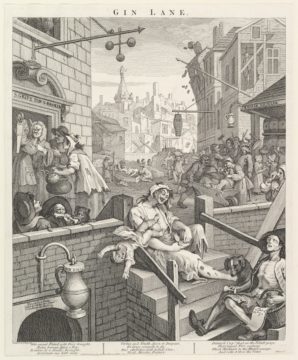James Brown in the Public Domain Review:
 In 1751, the engraver and satirist William Hogarth created Gin Lane, his celebrated visual retrospective about the devastating effects of this newfangled spirit on the lives of London’s poor. The print, a companion piece to Beer Street, offers a harrowing panorama of poverty, addiction, insanity, violence, infanticide, and suicide; the only people and institutions who thrive amongst the mayhem and despair are an undertaker, “Gripe” the pawnbroker, and the two purveyors of the “deadly draught”: a cellar gin shop and “Kilman” the distiller. In the words of Hogarth’s most recent biographer, Gin Lane’s “racked scene of dissolution . . . imprints itself indelibly on the mind”.1 Derivatives are beloved of political cartoonists, and so frequent and dependable is its appearance at academic conferences on alcohol history that a “gin lane klaxon” is scurrilously sounded on social media. However grotesquely transfixing the image, its dominance within both the history of alcohol and art has occluded a wider and subtler range of representations of gin and the environments in which it was consumed, which flourished across the eighteenth and nineteenth centuries.
In 1751, the engraver and satirist William Hogarth created Gin Lane, his celebrated visual retrospective about the devastating effects of this newfangled spirit on the lives of London’s poor. The print, a companion piece to Beer Street, offers a harrowing panorama of poverty, addiction, insanity, violence, infanticide, and suicide; the only people and institutions who thrive amongst the mayhem and despair are an undertaker, “Gripe” the pawnbroker, and the two purveyors of the “deadly draught”: a cellar gin shop and “Kilman” the distiller. In the words of Hogarth’s most recent biographer, Gin Lane’s “racked scene of dissolution . . . imprints itself indelibly on the mind”.1 Derivatives are beloved of political cartoonists, and so frequent and dependable is its appearance at academic conferences on alcohol history that a “gin lane klaxon” is scurrilously sounded on social media. However grotesquely transfixing the image, its dominance within both the history of alcohol and art has occluded a wider and subtler range of representations of gin and the environments in which it was consumed, which flourished across the eighteenth and nineteenth centuries.
More here.
